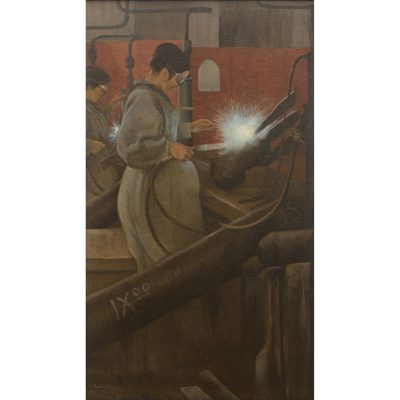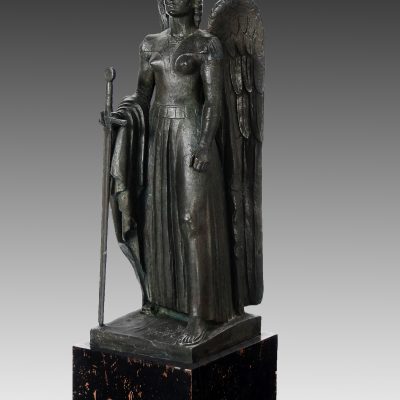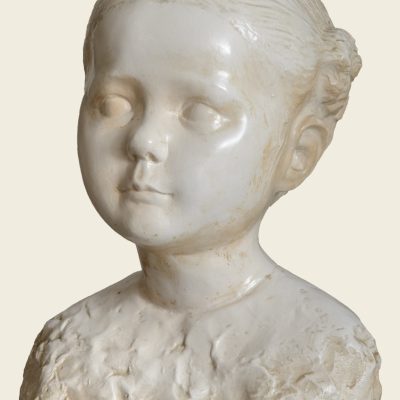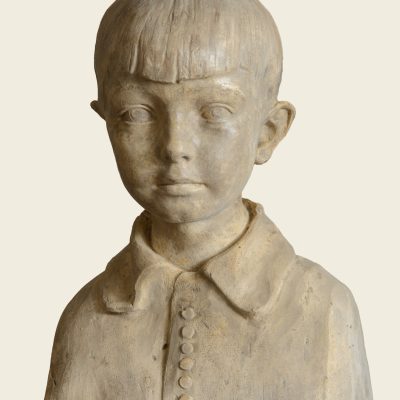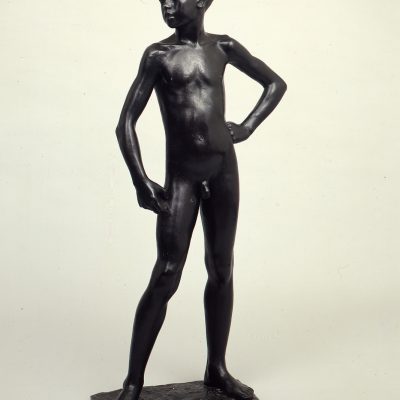This website uses cookies so that we can provide you with the best user experience possible. Cookie information is stored in your browser and performs functions such as recognising you when you return to our website and helping our team to understand which sections of the website you find most interesting and useful.
Fondazione Palazzo Ducale Genova
From November 22nd 2024
curated by Matteo Fochessati and Anna Vyazemtseva
The Wolfsoniana opens the new exhibition season and presents the latest acquisitions of the collection: the painting La Madre (1921) by Giovanni Costantini, and two sculptures by Guido Galetti – Giacomino (circa 1922) and Gioiella (1940), received by the Wolfsoniana as a donation from the artist’s heir Federico Bagni.
The painting La Madre (1921) by Giovanni Costantini was recently purchased and loaned to the museum by the Association The American Friends of the Palazzo Ducale Genoa, established in 2020 with the aim of spreading information among the American public about the exhibitions and other cultural activities put on by the Wolfsoniana and Palazzo Ducale and financially supporting their projects, as well as establishing a collaborative exchange with the Wolfsonian-Florida International University and other museums, foundations and educational institutions in the United States.
Giovanni Costantini (Rome 1872 – 1947) was trained in the workshops of the artists Alessandro Bazzani and Gioacchino Pagliei in Rome, and occasionally attended the evening life nude drawing school at the French Academy in Villa Medici. He exhibited for the first time in 1892, at the exhibition of the “Società di Amatori e Cultori di Roma”, and then carried out a continuous exhibition activity. In 1904 he joined the group “XXV della Campagna Romana”, which included Giulio Aristide Sartorio (1860–1932) and Duilio Cambellotti (1876–1960). He taught at the Academy of Fine Arts and from 1909 was a member of the Accademia di San Luca. During the First World War, although he did not take part in fighting directly, he was deeply affected by the harshness of the war events and conceived, between 1915 and 1921, the cycle Lacrime di Guerra (Tears of War) – a series of 45 paintings denouncing the war horrors. The paintings were exhibited at the First Roman Biennial, held in 1921 at the Palazzo delle Esposizioni in Rome. The Tears of War series, despite the extraordinary success with the public and the positive comments from critics, did not find the same enthusiasm in the political establishment; with the advent of fascism, Costantini’s humanist and pacifist vision was opposed by the emerging climate of rhetorical exaltation of heroism and militarism.
In 1924 Costantini worked on the reconstruction and restoration of the Mantegna frescoes in the Sala del Mappamondo in Palazzo Venezia in Rome and carried out the decoration of the Sala del Concistorio or Sala delle Battaglie. In 1925 he supervised the decoration of the entrance hall of the Italian pavilion for the International Exhibition in Paris, designed by Armando Brasini (1879–1965). He executed altarpieces for the churches of Santa Prisca (Madonna della Consolazione with Saint Augustine and Saint Monica, 1934) and Santa Maria del Popolo (Sacred Heart of Jesus, circa 1940, preserved in the choir) in Rome.
The painting La Madre (The Mother, 1921), recently acquired by the Wolfsoniana, is part of the series Tears of War, created by the artist after the end of the First World War: a heartbreaking pictorial protest of the horrors of a global conflict, in which for the first time the world powers clashed using the deadly technology of modern weapons. The painting depicts a woman in a factory assembling a bullet. The image, treating the modern themes – feminist and patriotic, shows the contradictory nature of this action: the woman, who is about to give birth to a new life, participates in the production of a weapon of death.
Next to La Madre on display is the painting by the futurist artist Alba Giuppone (Bern 1902 – Chivasso, Turin 1978) Donne in tempo di Guerra (Women in Wartime, 1942-1943) which represents a similar subject in the different context of the Second World War; marked by a strong propagandistic intent, the painting was conceived a few months before the collapse of the fascist regime.
Guido Galletti (London 1893 – Genoa 1977) was one of the major exponents of twentieth-century sculpture in Liguria. Born in London in a family of Genoese goldsmiths, he trained at the Accademia Ligustica di Belle Arti in Genoa and soon became part of the artistic life of the city and from 1912 he exhibited at the major city and regional exhibitions. The First World War, in which Galletti took part as a combatant, left a profound impact on his artistic research. From the 1920s he taught sculpture at the City Lyceum of Art “Niccolò Barabino”. In 1925 he participated in the International Exhibition of Decorative Arts in Paris and was granted with the gold medal.
Between the two wars, Galletti was involved in the creation of several works commemorating the war dead, including the competition project for the Arco dei Caduti (1923, 2nd prize) and the marble sculpture La Vittoria Vigilante for the Casa dei Mutilati in Genoa (The Vigilant Victory for the House of War Wounded in Genoa, 1938, bronze sketch on display, donated to the Wolfsoniana by Alessandra and Francesca Molfino in 2018). Inspired by Michelangelo, with references to classicism, but also to nineteenth-century realism, Galletti’s language of those years was in line with the Novecento trend, in accordance with fascist rhetoric, as testified by two sculptures Balilla, realized in 1931 and in 1930 (from the Trust Francesco Tacchini Collection). At the same time, the artist cultivated a different expressive approach in a series of intimate works, portraits of friends and family, as Head of a woman. Giuditta, 1961 (Trust Francesco Tacchini Collection). In the post-war period, Galletti created several works for public, civil and religious commissions.
The two works on display, Giacomino (1922 circa) and Gioiella (1940), donated to the Wolfsoniana by the artist’s heirs, represent a precious testimony of his creative journey. The first is the plaster version of the Bust of a Child. Giacomino in bronze, exhibited at the Promotrice Genovese exhibition in 1922 and purchased by the Municipality (now in the collection of the Gallery of Modern Art in Genoa); the second is the ceramic version of the marble portrait of the same title exhibited at the XXII Venice Biennale in 1940, when the artist won the prize as the best Italian sculptor. The materials and the immediacy of execution further highlight the delicate and intimate psychological and familiar nature of these works.
